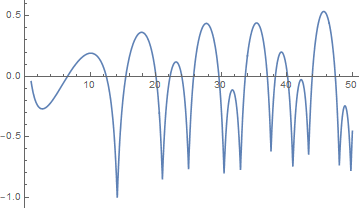Asymptotic Behavior of the Integral I ( t )
∫
1
1
/
2
log
∣
ζ
(
a
+
i
t
)
∣
d
a
I(t)=∫
1
1/2
log∣ζ(a+it)∣da as
t
→
∞
t→∞
To analyze the asymptotic behavior of the integral
I ( t )
∫
1
1
/
2
log
∣
ζ
(
a
+
i
t
)
∣
d
a
,
I(t)=∫
1
1/2
log∣ζ(a+it)∣da,
as
t
→
∞
t→∞, we begin by examining the known behavior of
log
∣
ζ
(
a
+
i
t
)
∣
log∣ζ(a+it)∣As suggested in different regions of
a
a as
t
t grows large.
- Behavior of log ∣ ζ ( a
i t ) ∣ log∣ζ(a+it)∣
For large t t, the behavior of log ∣ ζ ( a + i t ) ∣ log∣ζ(a+it)∣ varies depending on the real part a a.
a. For a
1 a=1: Near a
1 a=1, the zeta function exhibits a pole at s
1 s=1, which implies that ζ ( 1 + i t ) → ∞ ζ(1+it)→∞ as a → 1 a→1. The asymptotic behavior of ζ ( 1 + i t ) ζ(1+it) is well-approximated by:
ζ
(
1
+
i
t
)
∼
1
1
+
i
t
,
ζ(1+it)∼
1+it
1
,
which leads to
log ∣ ζ ( 1 + i t ) ∣ ∼ − log t as t → ∞ . log∣ζ(1+it)∣∼−logtast→∞. Thus, as t t increases, log ∣ ζ ( a + i t ) ∣ log∣ζ(a+it)∣ near a
1 a=1 grows negatively, contributing a large negative term to the integral.
b. For a
1 / 2 a=1/2: Near a
1 / 2 a=1/2, the function ζ ( 1 / 2 + i t ) ζ(1/2+it) exhibits more oscillatory behavior due to the influence of the non-trivial zeros of the Riemann zeta function. While ζ ( 1 / 2 + i t ) ζ(1/2+it) fluctuates, the average size of ∣ ζ ( 1 / 2 + i t ) ∣ ∣ζ(1/2+it)∣ can be described asymptotically as:
log ∣ ζ ( 1 / 2 + i t ) ∣
O ( log t ) . log∣ζ(1/2+it)∣=O(logt). Therefore, while the function exhibits strong oscillations near the critical line a
1 / 2 a=1/2, its logarithmic growth is much smaller than near a
1 a=1.
- Approximating the Integral
Given the behaviors at a
1 a=1 and a
1 / 2 a=1/2, we can now approximate the integral I ( t ) I(t). For large t t, the dominant contribution comes from the region near a
1 a=1, where log ∣ ζ ( a + i t ) ∣ ∼ − log t log∣ζ(a+it)∣∼−logt. The contribution from near a
1 / 2 a=1/2 is of smaller order and does not dominate the asymptotics.
Thuscomment, we approximate the integral as:
I
(
t
)
∼
∫
1
1
/
2
−
log
t
d
a
.
I(t)∼∫
1
1/2
−logtda.
This simplifies tohere are some plots:
I ( t ) ∼ − log t ⋅ ∫ 1 1 / 2 d a
− log t ⋅ ( 1 − 1 2 )
−
1
2
log
t
.
I(t)∼−logt⋅∫
1
1/2
da=−logt⋅(1−
2
1
)=−
2
1
logt.
3. Conclusion
Plot[NIntegrate[Log[Abs[Zeta[a+I t]]],{a,1/2,1}],{t,1,50}]
As
t
→
∞
t→∞, the integral
I
(
t
)
I(t) behaves asymptotically as:
I ( t ) ∼ − 1 2 log t . I(t)∼− 2 1 logt. This result reflects the fact that the dominant contribution to I ( t ) I(t) arises from the region near a
ParametricPlot[ReIm[NIntegrate[Log[Zeta[a+I t]],{a,1/2,1}]],{t,1,50},PlotPoints->150]
1
a=1, where
ζ
(
a
+
i
t
)
∼
1
1
+
i
t
ζ(a+it)∼
1+it
1
, leading to a logarithmic decay.
